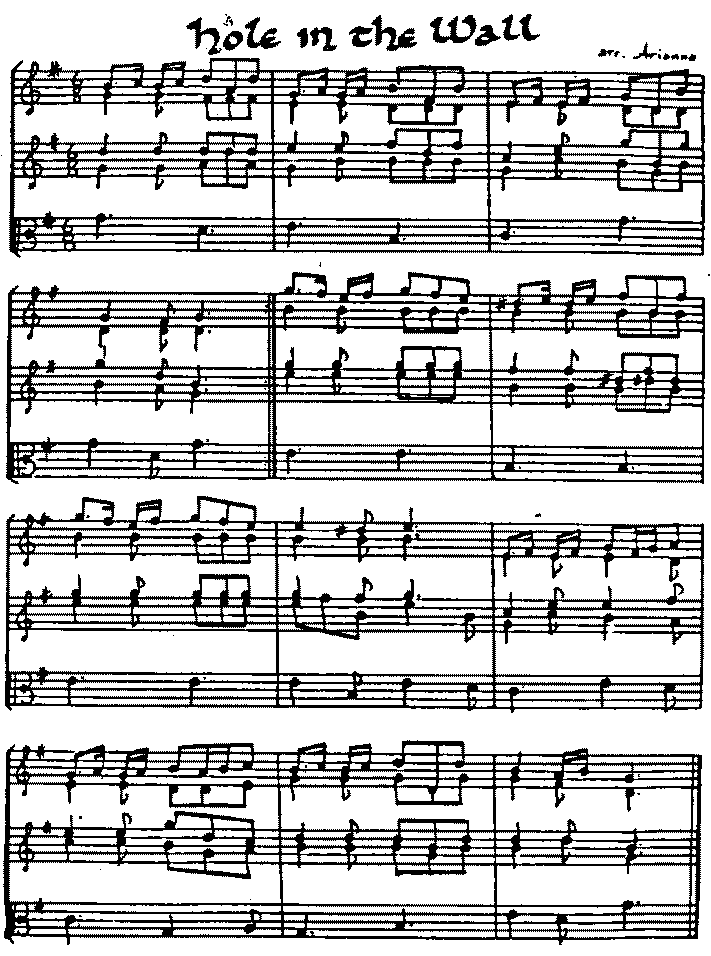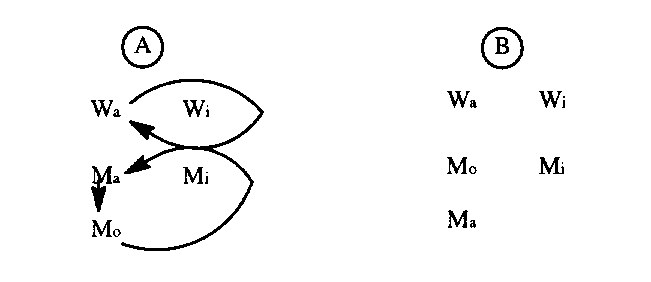
[ This article appeared in volume 1 of the Letter of Dance. ]
[I checked with my favorite source of dance arcana -- Baron Patri -- and got the following chronology for Hole in the Wall. Between the ninth (1695) and tenth (1698) editions of The English Dancing Master, there appeared an addendum, called The Second Part of the Dancing Master. Some copies of this have an extra sheet, which contains HiTW as well as a few other dances. By the 1698 edition of The Second Part, HiTW was in its main text, and it finally got into The English Dancing Master proper with the eleventh edition (1701). -- Justin]
Playford describes two broad types of dances: rounds, or bransles (pronounced brawls), and longways. The longway, which includes Hole in the Wall, is a dance done in double file with men and women in straight lines facing each other. In general, both rounds and longways are divided into a number of figures which include groups of three, arches, stars, place changing, moving in and falling back, crossing-over, hey, procession, swinging partners right and left, and many others (Sachs, 1965). Types of figures are many, with various combinations of finding and losing partners.
The origin of the country dances cannot be traced historically because at first they were purely folk dances. With the appearance of The English Dancing Master in 1651, the country dances had already been accepted in higher society. At the court of Queen Elizabeth, the contredanse was done by masters and servants together. The contredanse gained popularity rapidly, and remained popular into the early 1800's (Sachs, 1965).
Because of Hole in the Wall's appearance in a late edition of Playford (1725), and its absence from early editions (the first and third at least), there is much conjecture whether this dance falls within the period of the SCA. Because of its folk origins its time of origin is uncertain. The dance may have originated within the time frame of the SCA, but just gained popularity in court in the 1700's, thus gaining documentation in a later edition of Playford.
Kidnapping, cutting a person out of the line from the outside or exchanging partners within the lines, adds spice to the dance, and is generally done in informal situations. Kidnapping, described by Arbeau (1589) with respect to the Alman (as described below), is a period act, and is easily applied to Hole in the Wall. Kidnapping follows the light nature of the dance. The techniques of kidnapping are as varied as the imagination. The basic dance as generally done in the SCA and several kidnapping techniques are outlined herein.
"In dancing the Alman the young men sometimes steal the damsels from their partners and he who has been robbed seeks to obtain another damsel. But I do not hold with this behaviour because it may lead to quarrels and heart burning." -- Arbeau
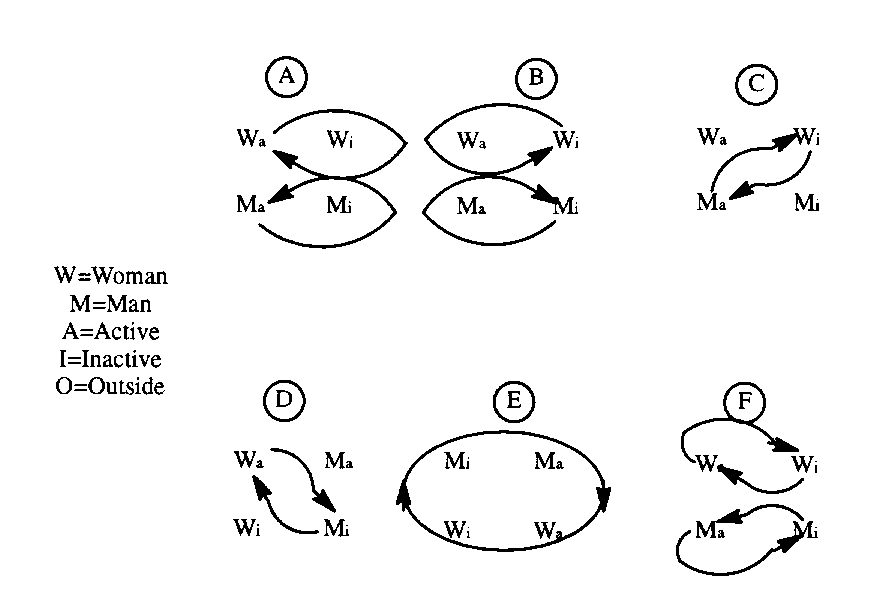
12 count reverence -- 6 to the presence and 6 to your partner
This is repeated with the active couple remaining active, moving down the line until they reach the end of the line, where they sit out one whole set and then take the inactive role. The inactive couple, like the active couple, continues to be inactive until they reach the head of the line, where they sit out one set and become active.

The idea of this technique of kidnapping is to step in front of the person who is "casting off," as in the diagram where Ma is the victim. The easiest way is to be in position to join hands with the victim's (Ma) partner (Wa) on the far side of Mi. All that has to be done is to stand there, without being in the way of the next couple, and wait for Wa to meet you and you have already blocked Ma from joining her.
To do it gracefully, you must be familiar with the counts of the music. For those not familiar with the music, you can stand directly behind your intended victim and pretend to "cast-off", always staying one step in front of the victim. This technique is very effective and is not easily foiled.
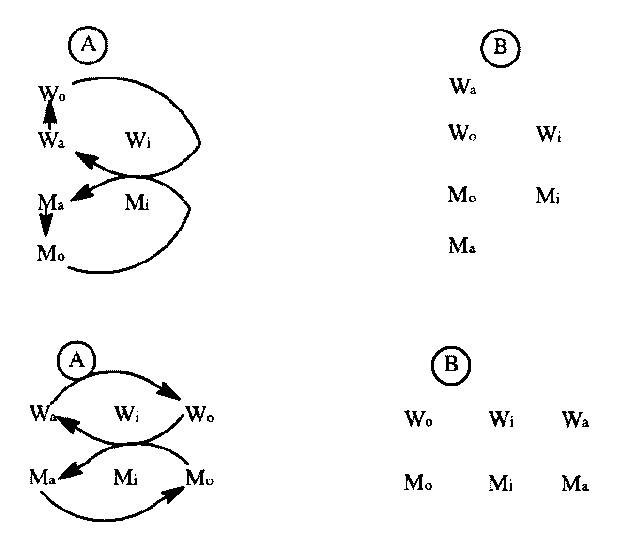
As it works out in the dance, when a couple reaches the end of the line of the dance, they stand out for an entire set, but it is possible for one or both members of the couple who are left out to jump in as though they were coming in from the outside, thus replacing, not removing, the victims.
It should be noted that this move can be used from within the line as well as from the ends, but caution must be used, because this can lead to confusion and easily disrupt the flow of the dance.
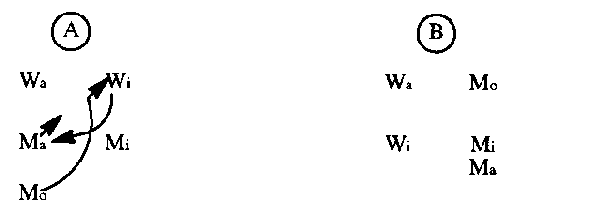
This technique works for kidnapping any position, active or inactive, male or female, but the diagram displays the role of the kidnapper (Mo) kidnapping out the active man (Ma). The idea is to step in front of your victim before he starts to cross over. Because timing is so crucial, it needs to be practiced before it is tried in a formal setting. If you do not successfully cut out your victim, abandon the move! This technique can easily be foiled.
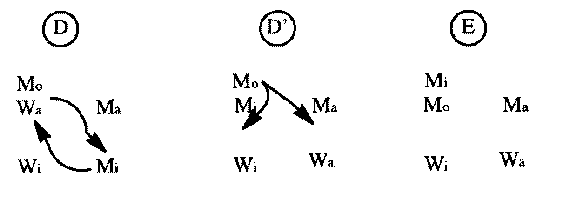
After the crossover has occurred, the kidnapper steps in front of either the active (Ma) or inactive (Mi) partner, as in figure D', which adds unpredictability to the move. It is important for the kidnapper to know which position (A or I) he or she is moving into. The kidnapper must also join hands with the people on either side before his victim has the opportunity and finish the set. It is important to know what you are doing, or this move can lead to confusion.
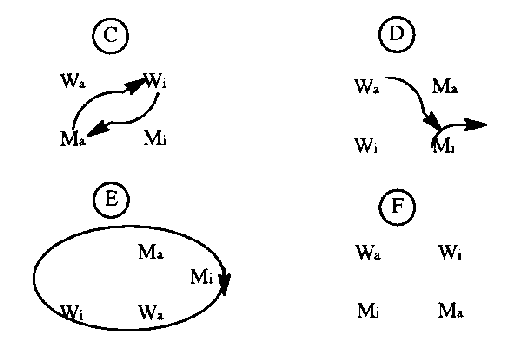
For this technique, the first crossover occurs as usual (C), and the second begins normally, but halfway through, the inactive man (Mi) takes the right hand of the active woman (Wa) with his left hand. Rather than moving into his normal spot, Mi walks in front of Ma, and places himself halfway between Ma and Wa, facing into the circle. This changes the role of the men and their partners. The kidnap is basically complete. The roles of the women do not change. In the circle (E), the men must take smaller steps to even out the circle and keep in time with the music. It is possible for the active man to foil the kidnap attempt. If the active man gently takes his partner's wrist or arm above the kidnapper's hand, the inactive man cannot pass. Do not fight for the woman. If the attempt fails, let it!
The only difference between the man and woman who executes this kidnapping technique is that the man starts inactive and becomes active, and the woman starts active and becomes inactive.
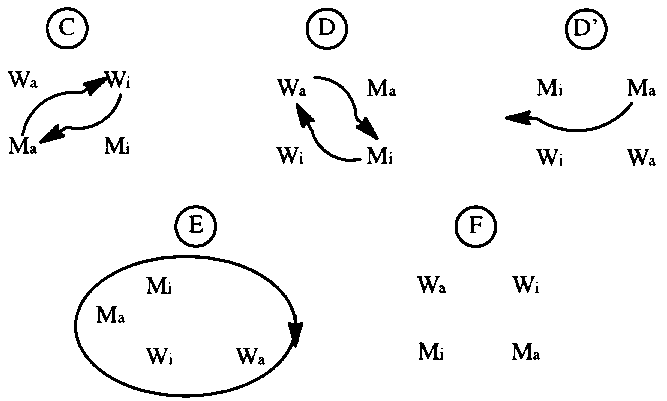
In this kidnap, like the previous one, the first crossover (C) occurs normally. The second crossover also occurs normally (D), but while the inactive man and active woman are getting into their places and before the circle can be formed (D'), the active man (Ma) steps around the inactive man (Mi), finding a place between Mi and Wi, thus separating the inactive couple. The men's roles are therefore exchanged. In this case, the men must take larger steps in the circle to preserve the continuity of the dance. This move should be practiced because the timing is so important. If this move is not done right, people will be tripping over each other, but when it is done right, it is a difficult kidnap to foil.
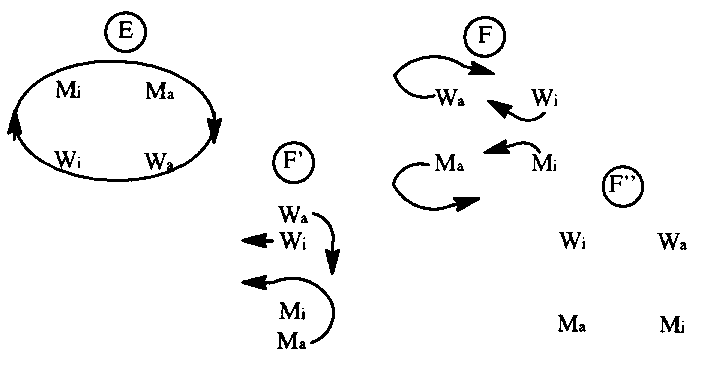
In a situation such as kidnapping, a certain amount of etiquette is necessary. First, before the dance begins, ask if kidnapping will be allowed. If the consensus is "no", don't do it. If "yes", have fun. Secondly, it is generally bad etiquette when you are kidnapped out of a line to kidnap back into the same group directly. With the many techniques available, it is easy to get your old partner back if you wish. Think ahead and see which way your old partner is moving in the line. Then use an outside kidnap to get back into the line ahead of your old partner and in one of the sets to follow, use an inside kidnap to retrieve your old partner.
Knowing the methods of kidnapping gives you mobility within the line of dance, and allows you to dance with whomever you wish. It also allows you to meet and talk to new people. These are only a few of the many various methods of kidnapping in Hole in the Wall. With a little etiquette, we may avoid the same problems disdained by Arbeau ("... this behaviour ... may lead to quarrels and heart burning.") Most of all, have fun!
Care, Alia Wasa (Lynn Symborski), 1979, Eastern Kingdom Dance Book
Clyula, Aiden Glyn, and Rosanore of Redthorn, Nordskogen Dance Manual
Dirk Sterne, Gwendolyn (Sue Wallis), 1985, Dance Manual of Dances Taught at the Stargate Dance Workshop
Playford, John, 1651, ?, 1725, The English Dancing Master, or Directions to Country Dances, 1st, 3rd, 18th editions, W. Pearson, London
Sachs, Curt, 1965, World History of Dance, translated by Bessie Schonberg, W.W. Norton and Co., Inc., New York
Wynthrop, Arianna of (Karen A. Speltnik), A Book of Dance Tunes Arranged for a Quintet of Instruments, East Kingdom Arts & Sciences Publication #3, April 23, AS 17 (NOTE: This book is not copyright, and Karen in her preface encourages the sharing of her arrangements)
